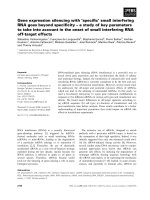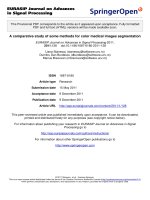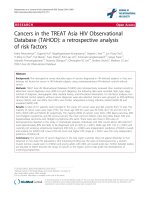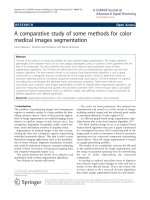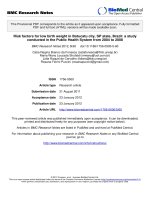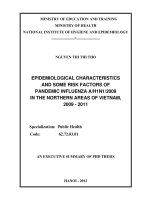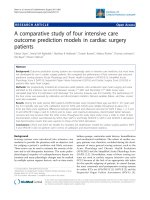a population study of risk factors for autism spectrum disorders in the faroe islands
Bạn đang xem bản rút gọn của tài liệu. Xem và tải ngay bản đầy đủ của tài liệu tại đây (2.29 MB, 201 trang )
Glasgow Theses Service
Kočovská, Eva (2014) A population study of risk factors for autism
spectrum disorders in the Faroe Islands. PhD thesis.
Copyright and moral rights for this thesis are retained by the author
A copy can be downloaded for personal non-commercial research or
study, without prior permission or charge
This thesis cannot be reproduced or quoted extensively from without first
obtaining permission in writing from the Author
The content must not be changed in any way or sold commercially in any
format or medium without the formal permission of the Author
When referring to this work, full bibliographic details including the
author, title, awarding institution and date of the thesis must be given
1
A
A
P
P
o
o
p
p
u
u
l
l
a
a
t
t
i
i
o
o
n
n
S
S
t
t
u
u
d
d
y
y
o
o
f
f
R
R
i
i
s
s
k
k
F
F
a
a
c
c
t
t
o
o
r
r
s
s
f
f
o
o
r
r
A
A
u
u
t
t
i
i
s
s
m
m
S
S
p
p
e
e
c
c
t
t
r
r
u
u
m
m
D
D
i
i
s
s
o
o
r
r
d
d
e
e
r
r
s
s
i
i
n
n
t
t
h
h
e
e
F
F
a
a
r
r
o
o
e
e
I
I
s
s
l
l
a
a
n
n
d
d
s
s
Eva Kočovská
School of Medicine
College of Medical, Veterinary and Social Studies
A thesis submitted in part fulfilment of the requirements
of the degree of Doctor of Philosophy
September 2014
2
To Elizabeth and Veronica
3
4
ABSTRACT
Objectives: To study autism spectrum disorder (ASD) in the Faroe Islands,
including prevalence, diagnostic stability and environmental factors that are
potentially involved in the aetiology of autism.
Method: I. The target group was recruited from the entire population sample of
participants with ASD during a two-phase screening and diagnostic process of the
entire Faroe Islands population in the relevant school age group born between 1985-
1994 (7-16 years, n=7,689) in 2002 and again in 2009 (15-24 years, n= 7,128) using
an independent clinical diagnosis and standardised tools. II. The diagnostic stability
of ASD from childhood to early adulthood over a period of 7 years compared
diagnoses in 2002 and 2009. III. A literature search of vitamin D and ASD covering
the period from January 1 1995 to October 31 2011 was carried out. IV. A pilot
study involved questioning 20 mothers of young individuals from the target group
and 13 mothers of healthy comparisons, regarding mothers‘ diet habits, health, life-
style and well-being during their pregnancy with an index child. V. 25-
hydroxyvitamin D
3
(25(OH)D
3
) levels were examined in a population based cross-
sectional study that involved 219 individuals: 40 participants with a diagnosis of
ASD from the target group (31 males/9 females), their 62 typically developing
siblings (29 brothers/33 sisters), their 77 parents (40 mothers/37 fathers), and 40
healthy comparisons (28 males/12 females).
Results: I. The rate of ASD rose significantly from 0.56% (n=43) in 2002 to 0.93%
(n=66) in 2009. Although these results were still within the range of typical findings
from other studies, of the 24 newly discovered cases in 2009 nearly half were
females thus altering the male/female ratio from 6/1 to 2.7/1. II. The stability of
clinical ASD diagnosis was perfect for AD, good for ―atypical autism‖/PDD-NOS,
and less than perfect for Asperger syndrome (AS). Stability of the diagnoses made by
means of research tools were more variable but still good for AD. Both systems
showed excellent stability over the seven-year period for ―any ASD‖ diagnosis,
although a number of clear cases (especially in females) had been missed in the
original screening in 2002. These results support the notion that a single overarching
diagnostic category, ‗autism‘ or ASD, would better suit clinical realities as outlined
in the new DSM-5. III. The systematic review (in 2010) provided some, albeit very
5
limited, support for the possible role of vitamin D deficiency in the pathogenesis of
ASD: there are three main areas of involvement of vitamin D in the human body that
could potentially have direct impact on the development of ASD: (1) the brain, (2)
gene regulation and (3) the immune system. The prevalence of ASD has been
suggested to be raised at higher latitudes. IV. Mothers of individuals with ASD had
had during their pregnancy significantly less positive ―attitude to sun‖ (p=0.001),
consumed fewer vegetables (p=0.026) and also less fruit (p=0.078). V. The ASD
case group had significantly lower 25(OH)D
3
levels (24.8 nmol/L) than their
typically-developing siblings (42.6 nmol/L, p<0.001) and their parents (44.9
nmol/L, p<0.001), and also significantly lower than healthy age and gender matched
comparisons (37.6 nmol/L, p=0.002). There was a trend for males having lower
25(OH)D
3
levels than females. There was no association between vitamin D and age,
month/season of birth, IQ or subcategories of ASD. Among the ASD group, 60%
were severely deficient (<30 nmol/L) and 84.2% of the whole study sample (n=219)
had deficient/insufficient levels (<50/<75 nmol/L).
Conclusions: I. ASD prevalence in the Faroe Islands increased from 0.56% in 2002
to 0.93% in 2009 mainly due to missed cases in 2002, nearly half of them females.
II. There was diagnostic stability for the overall category of ASD over time in the
group diagnosed in childhood (7—16) years, but considerable variability with
regards to diagnostic sub-groupings. Diagnosing females require novel approach.
III. Vitamin D deficiency–either during pregnancy or early childhood–may be an
environmental trigger for ASD in individuals genetically predisposed to the broad
phenotype of autism. IV. There are some interesting differences in the diet and life-
style habits between mothers with a child with ASD and mothers with a healthy
child. The ASD-group‘s negative ―attitude to sun‖ may indicate some life-
style/health differences which may play a role in pathogenesis of ASD, especially in
combination with other environmental risk factors.
V. The present study, demonstrating an association between low levels of 25(OH)D
3
and ASD, is the first to be based in a total population and to use siblings, parents and
general population control groups. It adds to similar findings from other regions of
the world, indicating vitamin D deficiency in the population and especially in
individuals with ASD. As all groups were exposed to low levels of sunlight, the very
low 25(OH)D
3
in the ASD group suggests that some other underlying pathogenic
mechanism may be involved.
6
7
Faroe Islands. Photo by courtesy of Olavur Frederiksen.
8
Acknowledgements
All human achievements are the result of cooperation and this PhD is no exception –
behind its results lies hidden the strong teamwork of many excellent research minds,
hard-working people and the support of many wonderful colleagues, family members
and friends.
I would like to thank in particular:
My primary supervisor Dr Helen Minnis for being instrumental in the arrangement of
this PhD and for proof-reading my many drafts.
My co-supervisor Prof Christopher Gillberg for giving me the opportunity to work
on this high level research and fascinating project; for excellently ‗scaffolding‘ my
learning process of academic writing over the past 4 years; for introducing me to the
Faroe Islands during our adventurous trip there (my first) which ended in Norway
instead due to an unexpected snow-storm; for all his support during my field work
there; for many excellent brain-storming discussions and for his and his wife
Carina‘s hospitality when in Sweden.
My co-supervisor Dr Eva Billstedt for accompanying me to one of my trips to the
North, her highly valuable yet unassuming guidance, advice, help, friendly
hospitality and ever optimistic, cheerful support.
Dr Pál Weihe, my main collaborator in the Faroe Islands for all his inspirational
advice, research guidance, help and support - always delivered with his wonderful
sense of humour.
All collaborators in the Faroe Islands – Guðrið Andorsdóttir, Dr Jónrit Halling
(especially for leading the process of the renewal of the Ethics approval), Rannvá
Biskupstø, Ása Ellefsen, Hanna Kampmann, Dr Elsubeth Fossadal (for conducting
the dietary interviews) and Inger Gabrielsen for all their fantastic help – work done
above their own remits and for their always generous and friendly hospitality.
Professor Elisabeth Fernell, my vitamin D research ‗soul mate‘, for all her guidance,
encouragement and kind support.
Professor Philippe Grandjean for his interest in my work, advice and great inspiration
to help fight the world‘s ‗brain drain‘ situation.
The rest of the team in the Faroe Islands: Dr Sigurd Wang, Dr Tormóður Stóra, Erika
Lomstein Petersen and Gunnrið Jóanesarson (for preparation of the blood samples
for the analysis).
Robyn Shea and the staff from the Vitamins Laboratory at City Hospital,
Birmingham for analysing the vitamin D concentrations.
Dr David Young, Dr Alex McConnachie, Dr Sarah Barry, and Miss Nicola Greenlaw
for their assistance with the statistical analysis.
9
The funders: the Swedish Science Council, ALF and Professor Gillberg‘s funders,
Niklas Öberg Life Watch Award, Ragnar and Alexandra Söderberg for funding the
greater part of this PhD.
Professor Sally-Ann Cooper for her interest in my work.
Our wonderful secretary, Irene O‘Neill, for all her fantastic help and administrative
assistance, at critical moments done at the speed of light.
My Glasgow colleagues Fiona, Harriet, Rachel, Louise and Clare for all the lovely,
cheerful support and help.
The Swedish colleagues, who were all very welcoming, and namely the secretaries
Ingrid (for her assistance performed even during her holidays) and Anna (seemingly
working 24/7), Gunilla, Carmela, Bibbi (for our lovely chats and for sharing their
valuable PhD experience and kind support), and Nanna and Carina for their warm
hospitality.
A sponsor, who does not wish to be named, for funding the last 4 months of my PhD,
during which I collected and analysed the data for studies IV and V and wrote 2
papers. This period of great uncertainty made me stronger, more independent and
demonstrated my high commitment to this research project. Without the help of this
person however, my PhD would not have been completed.
My dear husband Pavel for bravely cooking and taking on all household chores and
teenager care during my work trips to the Faroe Islands and for his great support and
encouragement when menacing clouds threatened the sky and for absolutely
EVERYTHING with all my love.
To my mother for her kind care of Pavel‘s dying mother in Prague that allowed me to
continue my work on this PhD and for all her prayers.
All my dear friends – Rosemary, Allison, Sheila, Dalia, Lucy, Emma, Alice, Jan,
Caroline, Debbie, Jan, and Seonaid for their interest in my work, for their great
listening skills, and always wonderful and highly appreciated support when this
project turned into a PhD in resilience.
I am grateful for the knowledge, gained through my PhD work, on the subject of the
sunshine hormone calcitriol multifaceted abilities. Keeping my own vitamin D levels
in the optimal range of outdoor workers on the equator perhaps improved my own
wellbeing in spite of the latitude of Glasgow, Gothenburg, and Tórshavn and all the
PhD-related stress. I hope that the results of this work will help others too and
especially those with autism.
10
Author’s Declaration
This thesis represents the original work of Eva Kočovská unless explicitly stated
otherwise in the text and is divided into five studies (I-V see Table 2). The research
was carried out at the University of Glasgow under the supervision of Dr Helen
Minnis, Professor Christopher Gillberg and Dr Eva Billstedt during the period of
March 2010 to October 2013. The major part of the work described herein has been
published as listed below (including the studies I-V):
I. Kočovská, E., Biskupstø, R., Gillberg, I. C., Ellefsen, Á., Kampmann, H., Stórá,
T., Billstedt, E., & Gillberg, C. (2012) The rising prevalence of autism: A
prospective longitudinal study in the Faroe Islands. Journal of Autism and
Developmental Disorders, 42, 1959-1966.
II. Kočovská, E., Fernell, E., Billstedt, E., Minnis, H., & Gillberg, C. (2012).
Vitamin D and Autism: Clinical Review. Journal of Research in Developmental
Disabilities, 33, 1541-1550.
III. Kočovská, E., Billstedt, E., Ellefsen, Á., Kampmann, H., Gillberg, I. C.,
Biskupstø, R. Andorsdóttir, G., Stórá, T., & Gillberg, C. (2013). Autism in the Faroe
Islands: Diagnostic stability from childhood to early adult life. The Scientific World
Journal, Special Issue on ESSENCE, Article ID 592371,
IV. Kočovská, E., Andorsdóttir, G., Weihe, P., Halling, J., Fernell, E., Stórá, T.,
Biskupstø, R., Gillberg, I.C., Shea, R., Billstedt, E., Bourgeron, T., Minnis, H., &
Gillberg, C. (2014). Vitamin D in the General Population of Young Adults with
Autism in the Faroe Islands. Journal of Autism and Developmental Disorders. E-
published June 2014 DOI : 10.1007/s10803-014-2155-1
V. Kočovská, E., Weihe, P., Fossadal, E., Andorsdóttir, G., Biskupstø, R., Halling,
J., Minnis, H. & Gillberg, C. (2014). Dietary and lifestyle habits in pregnancy in the
Faroe Islands. Brief Report. Manuscript in preparation.
11
TABLE OF CONTENTS
ABSTRACT 4
Acknowledgements 8
Author’s Declaration 10
TABLE OF CONTENTS 11
ABBREVIATIONS 17
A. BACKGROUND 21
B. INTRODUCTION 25
B.1. Autism spectrum disorder: a brief review of past and
present concepts 25
B.1.1. Clinical presentation of ASD 25
B.1.2. Psychological aspects 26
B.1.3. Comorbidities in ASD 27
B.1.3.1. ESSENCE 27
B.1.3.2. Medical Comorbidities 28
B.1.4. Neuropsychological aspects of ASD 29
B.1.5. Impact of ASD on individuals/families/society 29
B.1.5.1. Psycho-social consequences 29
B.1.5.2. Monetary impact 30
B.1.6. Diagnosis of ASD and diagnostic instruments 30
B.1.6.1. Definition, changing nature and social constructs 30
B.1.6.2. DSM-IV and DSM-5 32
B.1.6.3. Diagnostic instruments 32
B.1.7. Gender aspects in diagnosing ASD 33
B.1.8. Aetiology of ASD 36
B.1.9. Prevalence of ASD (I) 38
B.1.9.1. Global trends 38
B.1.9.2. Present study (I) 40
B.1.10. Diagnostic stability of ASD (II) 40
B.2. The Faroe Islands 42
B.2.1. Geography 42
B.2.2. Population 43
B.2.3. Genetic isolate 43
B.2.4. Faroese diet and pilot whale 44
12
B.3. Environmental Factors 46
B.3.1. A possible connection between methylmercury and
ASD 48
B.3.2. Why might methylmercury be an important environ-
mental factor for aetiology of autism? 48
B.3.3. Biological impact - Human health effects 49
B.3.4. Genetic sensitivity to methylmercury toxicity 53
B.4. Vitamin D deficiency 55
B.4.1. Vitamin D: definition, biosynthesis and role in
metabolism 55
B.4.2. Nomenclature 58
B.4.3. Dietary sources of Vitamin D 59
B.4.4. Vitamin D and autism 60
B.4.5. Vitamin D in the General Population of Young Adults
with Autism in the Faroe Islands (V) 62
C. AIM 63
D. METHODS 64
D.1. Participants 64
D.2. Screening methods (I, II, IV and V) 66
D.2.1. Target screening population in 2002 (I, II, IV and V) 66
D.2.2. Target screening population in 2009 (I, II, IV and V) 67
D.2.3. Instruments at screening 68
D.2.4. ASD study group Time 1 (2002) 68
D.2.5. ASD study group Time 2 (2009) 69
D.3. Student’s role (EK) 69
D.4. Measures and instruments (I, II, IV and V) 71
D.4.1. Diagnostic criteria (I, II, IV and V) 71
D.4.2. Diagnostic Interview for Social and Communication
Disorders (DISCO) 72
D.4.3. Other diagnostic instruments 72
D.4.4. Medical examinations and record data (I, II, IV and V) 73
D.4.5. Vitamin D and autism: Clinical review (III) 73
D.4.6. Dietary and life-style trends during pregnancy (IV) 75
D.4.6.1. Choice of method 75
D.4.6.2. Study population 76
D.4.6.3. Procedure 77
D.4.6.4. Measures 77
13
D.4.7. Vitamin D levels (V) 77
D.4.7.1. Study population 77
D.4.7.2. Blood sampling and assay of 25-hydroxyvitamin D
levels 79
D.4.7.3. Chemicals and reagents 80
D.4.7.4. Sample preparation 81
D.4.7.5. Sample analysis 81
D.4.7.6. Relationship between ideal sample type (serum)
and haemolysed whole blood 82
D.4.7.7. Vitamin D status 83
D.5. Statistical analyses 84
D.6. Ethics 85
E. RESULTS (I-IV) 87
E.1. Prevalence of autism in the Faroe Islands (I) 87
E.1.1. Overall number of suspected and definitive cases
identified 87
E.1.2. “New” cases referred with possible symptoms of ASD 89
E.2. Diagnostic stability (II) 94
E.2.1. Clinical subgroup characteristics according to
change/no-change of diagnostic category 95
E.2.2. CRC diagnoses versus DISCO-11 diagnoses in
diagnostic and follow-up studies 95
E.2.3. DSM-IV and DSM-5 diagnoses compared 96
E.2.4. Stability of DISCO-algorithm diagnosis 96
E.2.5. Correspondence between clinical diagnosis and
DISCO diagnosis in the follow-up study 97
E.2.6. Gender effects 97
E.2.7. Diagnosis and IQ levels 98
E.2.8. No diagnosis at follow-up 98
E.3. Vitamin D and autism: clinical review (III) 99
E.3.1. Systematic review 100
E.3.1.1. Plasma vitamin D-levels in individuals with
autism and their family members 100
E.3.1.2. Autism – vitamin D: Nutritional status, clinical
and case studies 101
E.3.1.3. Autism – vitamin D: Latitudinal effects and
ethnicity, clinical studies 103
E.3.2. Narrative Review 104
E.3.2.1. Autism – vitamin D: Epilepsy and seizures 105
14
E.3.2.2. Autism – vitamin D: Medication during
pregnancy 105
E.4. Dietary and life-style trends during pregnancy (IV) 106
E.4.1. Dietary differences 106
E.4.1.1. Vegetables, fruit and potatoes 106
E.4.1.2. Pilot whale meat (a Faroese specific), blubber,
sea bird and fish 106
E.4.2. Life-style and health differences 107
E.4.2.1. Alcohol and smoking 107
E.4.2.2. Mental health, miscarriage, Caesarean section,
prematurity and birth weight 108
E.4.2.3. Life-style differences 108
E.4.3. Mercury exposure 111
E.4.3.1. Mercury exposure data available from the
Previous studies 111
E.4.3.2. Comparison of mercury levels with available data 112
E.5. Vitamin D in the general population of young adults
With autism In the Faroese Islands (V) 113
E.5.1. 25(OH)D
3
Levels 113
E.5.2. Analysis of season of blood sampling 116
E.5.3. Comparison of 25(OH)D
3
levels across and within
gender 116
E.5.4. Comparison of 25(OH)D
3
levels in individuals with
ASD recruited in 2002 and 2009 117
E.5.5. 25(OH)D
3
levels and other variables 117
F. DISCUSSION (I-V) 119
F.1. Prevalence of Autism in the Faroe Islands (I) 119
F.1.1. ASD Prevalence in the Faroe Islands 119
F.1.1.1. The representativeness of the sample 119
F.1.1.2. Agreement between the diagnostic instruments 120
F.1.2. Exploration of reasons behind growing
incidence/prevalence of ASD world-wide 120
F.1.1.1. Diagnostic criteria, type of assessment,
inaccuracies and research methodologies 120
F.1.2.2. Gender aspects 122
F.1.2.3. Better perinatal care 122
F.1.2.4. Cultural factors 122
F.1.2.5. Environmental factors 123
F.1.3. Strengths and limitations 124
F.1.3.1. Limitations 124
F.1.3.2. Strengths 125
F.1.4. Conclusions 125
15
F.2. Autism in the Faroe Islands: Diagnostic Stability from
Child to Early Adult Life (II) 126
F.2.1. ASD and intellectual disability/age 126
E.2.1.1. Comparison of clinical and DISCO diagnostic
stability 126
E.2.1.2. Evaluation of the diagnostic process 126
E.2.1.3. DISCO and its psychometric properties 126
E.2.1.4. Diagnosticians 127
E.2.1.5. Possible reasons behind a number of missed cases
in 2002 127
E.2.1.6. Gender effects 128
E.2.1.7. Outcomes 129
F.2.2. No diagnosis on follow-up 129
E.2.2.1. A case of the present study 129
E.2.2.2. Additional research findings 129
F.2.3. ASD and intellectual disability/age 130
F.2.4. Strengths and limitations 131
E.2.4.1. Limitations 131
E.2.4.2. Strengths 132
F.2.5. Conclusions 132
F.3. Autism – vitamin D: Clinical Review (III) 133
F.3.1. Overview of the systematic literature review 133
F.3.2. Hypotheses of involvement of vitamin D in aetiology
of ASD from the narrative review 133
F.3.2.1. An autoimmune hypothesis of ASD 133
F.3.2.2. Other hypotheses 134
F.3.3. Vitamin D and epilepsy 134
F.3.4. Vitamin D and nutrition 135
F.3.5. Strengths and limitations 136
F.3.5.1. Limitations 136
F.3.5.2. Strengths 136
F.3.6. Conclusions 136
F.4. Dietary and life-style trends during pregnancy in the
1980s-1990s in the Faroe Islands – pilot study (IV) 137
F.4.1. Outcomes of the dietary questionnaire pilot study 137
F.4.2. Faroese studies of prenatal mercury exposure 138
F.4.3. Methylmercury 140
F.4.3.1. Balancing the risks and benefits of the seafood
consumption 141
F.4.3.2. Methylmercury toxicity and genetic factors 142
F.4.3.3. Special features of the present study cohort 143
F.4.4. Strengths and limitations 144
F.4.4.1. Limitations 144
F.4.4.2. Strengths 145
F.4.5. Conclusions 145
16
F.5. Vitamin D in the General Population of Young Adults
in the Faroe Islands (V) 146
F.5.1. The present study in the context of existing knowledge 146
F.5.2. Seasonal variations of vitamin D deficiency 149
F.5.3. Vitamin D deficiency and gender aspects 150
F.5.4. Vitamin D deficiency and Body Mass Index (BMI) 150
F.5.5. Vitamin D deficiency and possible underlying
hormonal imbalance 151
F.5.6. Multi-functional character of the hormone calcitriol 153
F.5.6.1. Vitamin D and the immune dysregulation 153
F.5.6.2. Vitamin D and the ESSENCE syndromes 154
F.5.6.3. Multifaceted character of the hormone calcitriol 154
F.5.7. Strengths and limitations 155
F.5.7.1. Limitations 155
F.5.7.2. Strengths 155
F.5.8. Conclusions 156
F.5.9. Future directions 156
F.5.10. The research and clinical implications of the work 157
G. SUMMARY 159
H. REFERENCES 161
I. APPENDICES 187
Appendix 1. Dietary Questionnaire 2011 188
Appendix 2. A personal experience of the climate in the Faroe Islands 193
Appendix 3. Paper I 196
Appendix 4. Paper II 197
Appendix 5. Paper III 198
Appendix 6. Paper IV 199
17
ABBREVIATIONS
Abbreviation Description
1,25(OH)
2
D calcitriol 1,25-dihydroxycalciferol, or cholecalcitriol
1,25(OH)
2
D
3
calcitriol for 1,25-dihydroxycholecalciferol
25(OH)D calcidiol, or cholecalcidiol.
25(OH)D
3
calcidiol, or 25-hydroxy-cholecalciferol
A Average intelligence (IQ 85-114)
AA Above Average intelligence (IQ≥115)
AD Autism/Autistic Disorder
ADD Attention Deficit Disorder
ADHD Attention-Deficit/Hyperactivity Disorder
ADI-R Autism Diagnostic Interview-Revised
ADOS Autism Diagnostic Observation Schedule
ADOS-G Autism Diagnostic Observation Schedule-Generic
APA American Psychiatric Association
AS Asperger‘s Syndrome
ASD Autism Spectrum Disorder
ASSQ Autism Spectrum Screening Questionnaire
ATEC Autism Treatment Evaluation Checklist
BD Bipolar disorder
BDNF Brain-derived neurotropic factor
BISCUIT Baby and Infant Screen for Children with aUtIsm Traits
BMI Body Mass Index
Br
–
Bromide
CARS Childhood Autism Rating Scale
CH
3
HgX Methylmercury salt (X is typically a halogen),
CI CI confidence intervals
Cl
–
Chloride
CNS Central nervous system
CNV Copy number variants
CPA Commercial Product Assurance
18
CRC Clinical Research Comprehensive (diagnosis)
DCD Developmental Coordination disorder
7DHC 7-Dehydrocholesterol
DEQAS (Vitamin) D External Quality Assessment Scheme
DISCO Diagnostic Interview for Social and COmmunication Disorders
DISCO-10 Diagnostic Interview for Social and COmmunication Disorders.
10
th
version.
DISCO-11 Diagnostic Interview for Social and COmmunication Disorders.
11
th
version
DNA Deoxyribonucleic acid
DSM-4 Diagnostic and Statistical Manual of Mental Disorders. 4
th
Edition
DSM-5 Diagnostic and Statistical Manual of Mental Disorders. 5
th
Edition
EDTA Ethylenediamine tetraacetic acid
EPA The US Environmental Protection Agency
ESSAT Early Screening of Autistic Traits
ESSENCE Early Symptomatic Syndromes Eliciting Neurodevelopmental Clinical
Examinations
F Female
FFQ Food Frequency Questionnaire
FSIQ Full Scale IQ
GLM General Linear Model
GP General Practitioner
Hg Mercury
Hg
0
Mercury – metallic (oxidation state 0)
Hg
I
Mercury (oxidation state +1)
Hg
II
Mercury (oxidation state +2)
I
–
Iodide
ICD-10 International Classification of Diseases. 10
th
Edition
IDD Intellectual developmental disorder
IQ Intelligence quotient
IQR Inter-Quartile Range
IU International Unit(s)
LC-MS/MS Liquid Chromatography-Mass Spectrometry/Mass Spectrometry
LD Learning Disability
19
LD/ID Learning/Intellectual Disabilities
M Male
MAG Myelin Associated Glycoprotein
M-CHAT Checklist for Autism in Toddlers
MeHg Methylmercury (chemically inaccurate abbreviation)
MLD Mild Learning Disability (IQ 50-69)
N North (latitude)
NA Near Average intelligence (IQ 70-84)
NAMMCO North Atlantic Marine Mammal Commission
NATO North Atlantic Treaty Organization
ng/mL Nanogram per millilitre
nmol/L Nanomol per litre
NO
3
–
Nitrate
o
C Centigrade (degree of Celsius)
OCD Obsessive Compulsive Disorder
ODD Oppositional defiant disorder
OH
–
Hydroxide
PCB Polychlorinated biphenyl
PCBs Polychlorinated biphenyls
DDE Dichlorodiphenyldichloroethylene
PDD Pervasive Developmental Disorder
PDD-NOS Pervasive Developmental Disorder Not Otherwise Specified
PGR Progesterone receptor
PIQ Performance IQ
PON1 Paraoxonase
prcP Urinary porphyrin precoproporphyrin
PSI Processing Speed Index
PRISMA Preferred Reporting Items for Systematic Reviews
PTH Parathyroid hormone
PUFA Polyunsaturated fatty acids
RfD Reference dose
ROS Reactive Oxidative Species
SCQ Social Communication Questionnaire
SD Standard Deviation
20
SH sulfhydryl (-SH)
SIB self-injurious behaviour
SID Social Interaction Disorder
SLD Severe Learning Disability (IQ≤49)
SLI Speech and language impairment (SLI)
SLOS Smith-Lemli-Opitz syndrome
SNP Single-Nucleotide Polymorphisms
Sq km Square kilometre
TF Transferrin
UV Ultra Violet
UVB Ultra Violet light in B-region (wavelength at 290-320 nm)
VDR Vitamin D Receptor
Vitamin D Vitamin D in general.
Vitamin D
2
Ergocalciferol (derived from ergosterol)
Vitamin D
3
calciferol for cholecalciferol (derived from cholesterol)
VIQ Verbal IQ
WADIC Wing‘s Autistic Disorder Interview
WAIS-R Wechsler Adult Intelligence Scale-Revised
WHO World Health Organization
WISC-III Wechsler Intelligence Scale for Children. Third Edition.
WISC-R Wechsler Intelligence Scale for Children-Revised
X
–
Anion with one negative charge, e.g., chloride (Cl
–
), bromide (Br
–
),
iodide (I
–
), hydroxide (OH
–
), and nitrate (NO
3
–
), etc.
µL microlitre
μg/L microgram per litre
21
A. BACKGROUND
Autism spectrum disorders (ASD) are a heterogeneous group of complex,
biologically based neurodevelopmental disorders that undermine optimal brain
development and are marked by altered communication and social skills, by
cognitive and learning deficits and by stereotypic behaviours. It has been well
established that genetic factors play a major role in development of autism (Levy et
al., 2009). However, establishing a discrete pathogenesis of autism has proven to be
extremely difficult. The common de novo point mutations that have been identified
are associated with only a small proportion of cases. Recent studies portray the role
of signalling pathways in the brain and the synapse structure as crucial to the
development of ASD (Gillberg & Coleman, 2000).
There is no agreement as to whether ASD prevalence is genuinely on the rise
or if a higher reported rate in recent years might be secondary to better awareness,
changing diagnostic trends and more sensitive diagnostic systems (Coleman et al.,
2011) and possibly also to diagnosing ASD in females only at older ages, alongside
the rising awareness of the existence of ASD in girls (Kopp & Gillberg, 1992;
Giarelli et al., 2010; Kočovská et al., 2013).
It is also clear that environmental factors, such as infectious diseases and
teratogen exposure in utero, can cause autism and that in some cases there must be an
interaction between genetic and environmental factors (Gillberg and Coleman, 2000).
Understanding gene-environment interactions in autism (Freitag et al., 2010) is
currently a very important topic for research into early neurodevelopment. To study
these interactions in genetic isolates with specific environmental exposures presents
itself as a model of choice for this type of research.
The Faroe Islands are situated in the heart of the Gulf Stream in the North
Atlantic Ocean, half way between Norway and Iceland at 62
o
00‘ N. Given the
genetic isolate character, the Faroe Islands constitute an interesting environment with
many variables being unusually stable, e.g., socioeconomic status, education, health
care, familial/genetic history and diet. There are several environmental factors
specific to this geographical region, which are likely to be of significance in the
interplay between the occurrence of autism and environmental and genetic variables,
such as methylmercury poisoning and vitamin D deficiency (Kočovská et al., 2014).
22
Mercury: Methylmercury is a well-established neurotoxicant that can have
serious adverse effects on the development and functioning of the human central
nervous system, especially when exposure occurs prenatally (World Health
Organization, 1990; Zahir et al., 2005; Johansson et al., 2007). The biological
plausibility of the hypothesis that mercury (Hg) is linked to neurodevelopmental
disorders, including autism, has been demonstrated on a cellular level (Garrecht &
Austin, 2011). Methylmercury has the capability of crossing the blood-brain barrier
and its lipophilic nature allows binding to neurons and acting as a very potent
neurotoxin. Chronic, low-dose prenatal exposure to methylmercury from maternal
consumption of seafood/fish has been associated with adverse neurodevelopmental
effects (attention, fine motor function, language, visual-spatial abilities and verbal
memory) (Grandjean et al., 1997; Debes, 2006). This pollutant is of considerable
public concern, because it is found in sea-food and freshwater fish throughout the
world (World Health Organization, 1990).
In this small homogeneous Nordic community large variations in seafood
intake occur whereas social differences are limited and the potential for other
neurotoxic exposures are also limited. Some residents have an excessive exposure to
methylmercury, mainly due to the traditional habit of eating pilot whale meat. It has
been known for a long time that pilot whale meat contains a large amount of mercury
(Juhlshamn et al., 1987).
Vitamin D: Calcitriol, the active form of vitamin D, is biosynthesised in the
body via a cascade of chemical transformations, initiated by a photochemical
reaction in the skin on exposure to the ultraviolet rays of the sun. The Faroe Islands'
location and its maritime climate (high rainfall, strong winds, an average summer
temperature of 9
o
C) reduces the availability of the UVB radiation of sun rays, which
has a negative impact on the natural production of vitamin D in the human body.
Conversely, the Faroe Islanders have a diet rich in large oily fish containing vitamin
D that could possibly, at least in part, compensate for the lack of UVB exposure,
which in turn might mean that overall vitamin D status in the Faroe Islands could be
adequate (Kočovská et al., 2014).
An apparent worldwide epidemic of vitamin D deficiency is now being
recognised (Holick, 2007). The prevalence of ASD has been suggested to be
increased at higher latitudes and in children of migrant mothers with darker skin
(Dealberto, 2011). Recently, maternal/neonatal vitamin D deficiency has been
23
proposed as a possible environmental risk factor for ASD (McGrath et al., 2001;
Cannell, 2008; Cannell & Grant, 2013; Grant & Soles, 2009; Kočovská et al., 2012a)
due to its unique role in brain homeostasis, embryogenesis and neurodevelopment,
immunological modulation (including the brain‘s own immune system), ageing, and
also, importantly, in gene regulation (Sigmundsdóttir, 2011; Harms, Burne, Eyles, &
McGrath, 2011; Ramagopalan et al., 2010). Interesting results, both at the molecular
level and in animal experiments (Fu et al., 1997; Neveu et al., 1994c; Eyles et al.,
2003; 2005), begin to indicate the possible mechanisms for this potential risk.
Indirect support for the involvement of vitamin D in ASD comes from ecological
studies, according to which vitamin D levels vary with season and latitude and with
the degree of skin pigmentation (Grant & Soles, 2009; Dealberto, 2011).
The end product of vitamin D biosynthesis is calcitriol (1,25-
dihydroxyvitamin D
3
or 1,25(OH)
2
D
3
), a neuroactive hormone that signals via
nuclear receptors (Eyles et al., 2005; Eyles, Burne & McGrath, 2013). The last 15
years have witnessed great advances in explaining the biochemical mechanisms of
the diverse actions of calcitriol in the brain, especially its role in early
neurodevelopment and in degenerative processes: (1) cell differentiation and axonal
growth; (2) stimulation of neurotrophic factor expression (e.g., cytokines); (3)
regulation of calcium signalling directly in the brain; (4) modulation of the
production of the brain-derived reactive oxygen species; (5) stimulation of
glutathione (a potent anti-oxidant, involved in DNA repair) and thereby down-
regulating excitotoxicity (Eyles, Burne & McGrath, 2013; Eyles et al., 2005; Garcion
et al., 2002; Cannell, 2013).
Since several of these processes are targeted by the devastating effects of Hg-
induced neurotoxicity within the brain, it is tempting to speculate that this diminished
protective function of calcitriol during early neurodevelopment (due to vitamin D
deficiency at higher latitudes) in conjunction with possible individual genetic
predispositions to autism and/or genetic predisposition to Hg toxicity and combined
with exposures of varying degrees to a number of other environmental factors, may
escalate into neurodevelopment disorder.
Thus studying the interplay of these two environmental factors, i.e., the
methylmercury toxicity and vitamin D deficiency, in the ASD population sample in
the genetically isolated Faroe Islands offers a unique edge for research.
24
The present study aims to disentangle the effects of gene-environment
interaction in autism in the Faroe Islands. Specifically, this study explores two
environmental variables: diet (methylmercury) and vitamin D deficiency. The results
were expected to have an influence on dietary counselling in autism spectrum
disorders (ASD) and on the development of more sophisticated research protocols for
studying gene-environment interaction in ASD.
